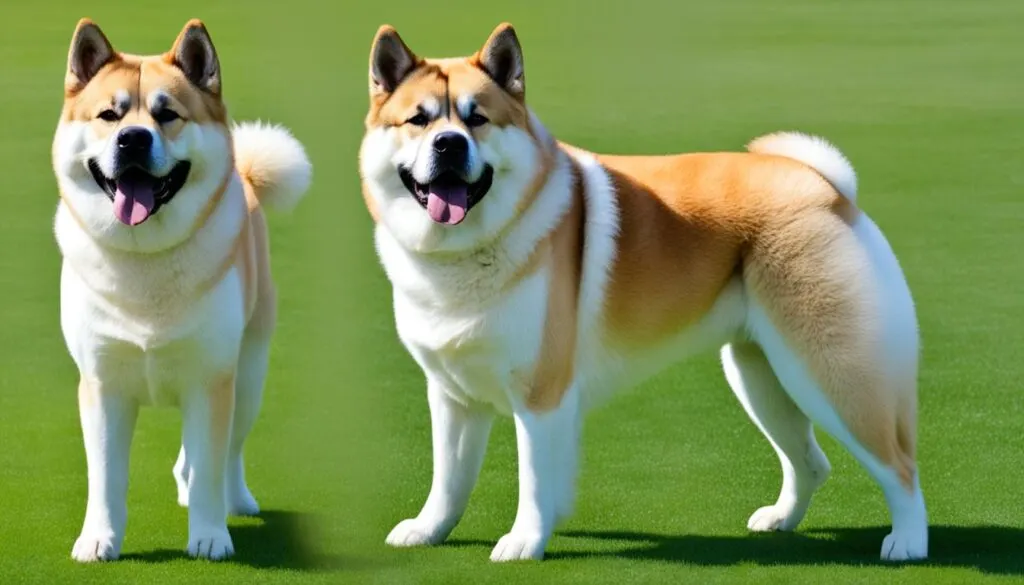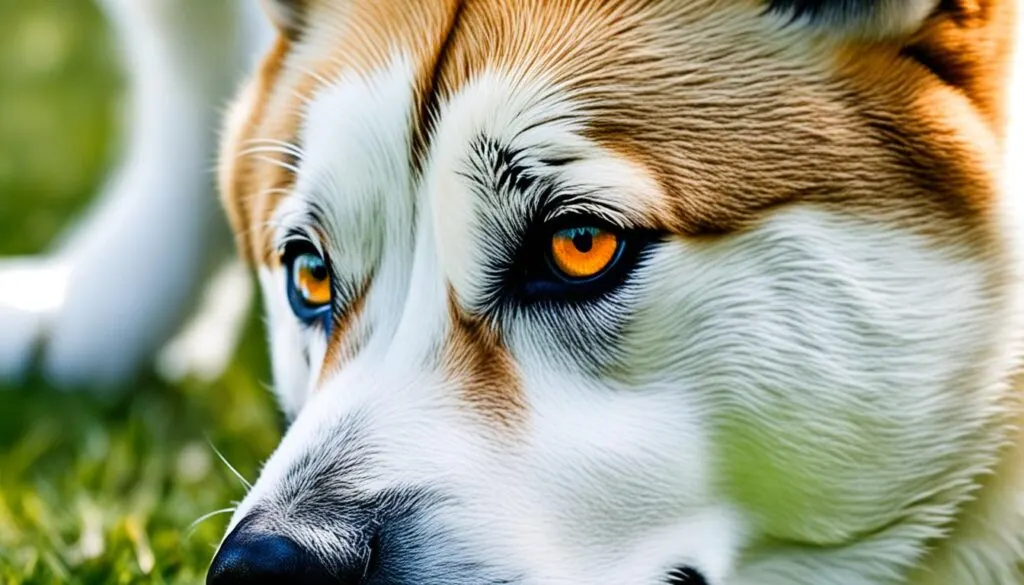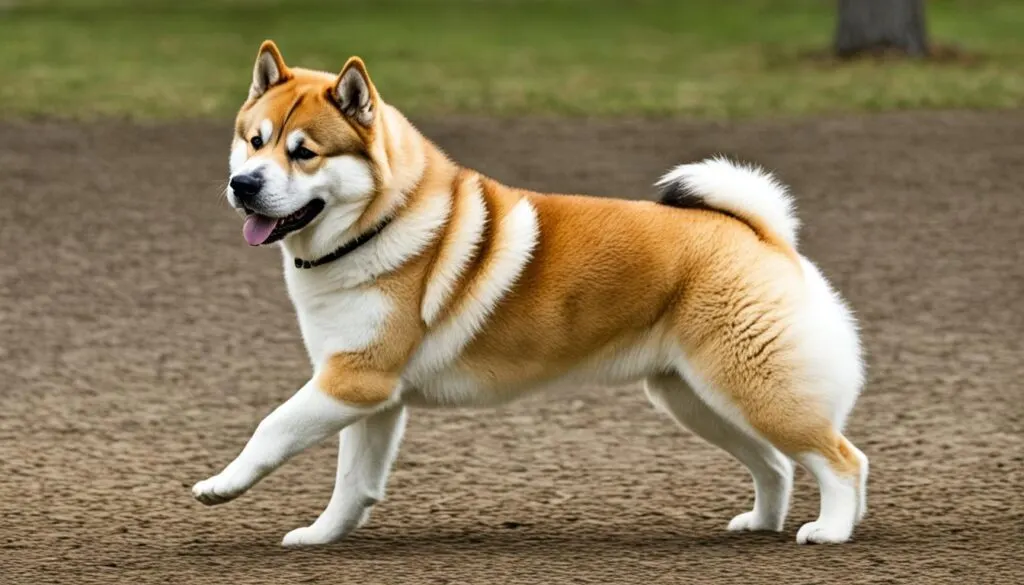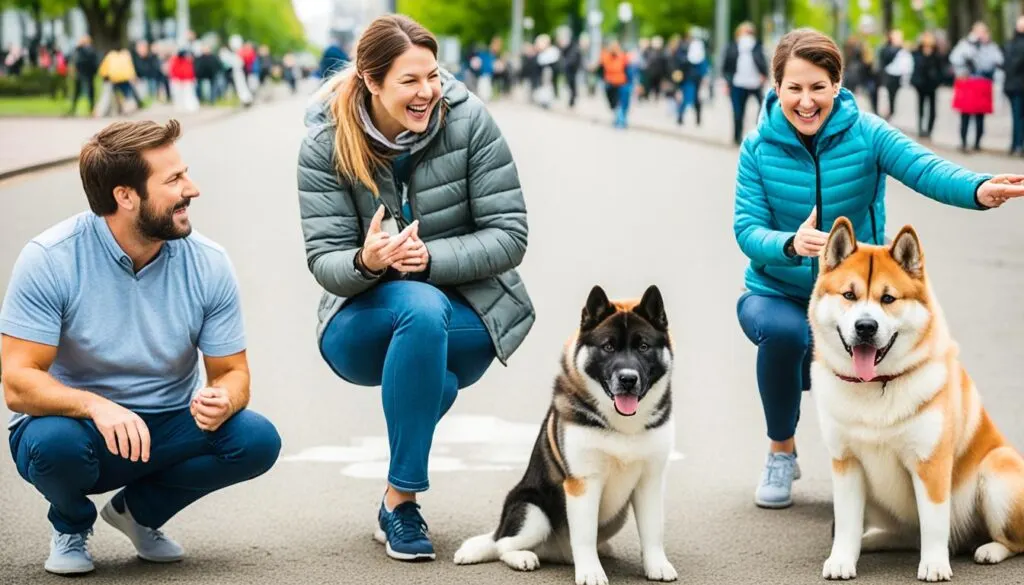Did you know that Akitas, one of the noblest and loyal dog breeds, have a unique and distinctive body language?
Understanding and decoding Akita body language is essential for improving communication and deepening your bond with these majestic companions.
Akitas primarily communicate through nonverbal cues, and their body language provides valuable insights into their emotions, needs, and intentions.
By learning how to interpret their signals effectively, you can ensure their well-being and happiness while strengthening your relationship.
In this comprehensive guide, we will explore various aspects of Akita body language, including tail wagging, raised hackles, posture, facial expressions, eye movements, vocalizations, and communication signs during play.
By understanding the meanings behind these signals, you will be able to navigate the intricacies of your Akita’s behavior and deepen your connection.
Click Here to Jump to a Section
Key Takeaways:
- Decoding Akita body language is crucial for understanding your Akita’s emotions and needs.
- Akitas primarily communicate through nonverbal cues such as tail wagging, raised hackles, and facial expressions.
- By interpreting Akita body language correctly, you can strengthen your bond and ensure their well-being.
- Understanding body language cues during play will enhance your interactions and make playtime more enjoyable for both you and your Akita.
- Consistent observation and interpretation of Akita body language will lead to improved care and responsiveness, fostering a harmonious relationship.
A Primer on Canine Communication Methods
Understanding how dogs communicate is essential for effectively interpreting their behavior and body language.
Canine communication involves a combination of verbal and nonverbal cues, with nonverbal cues playing a significant role.
These nonverbal cues, also known as canine communication cues, encompass various aspects such as body language, facial expressions, vocalizations, and more.
Nonverbal cues in dogs are especially important when it comes to understanding their emotions, intentions, and needs.
Dogs communicate primarily through body language, using subtle movements and gestures to convey their thoughts and feelings.
By learning to decipher these nonverbal cues, you can gain a deeper understanding of your dog and enhance your ability to communicate with them effectively.
However, it is important to note that many common misunderstandings can occur in human-dog interactions due to a lack of knowledge about canine body language.
People often misinterpret dog behavior based on human perspectives and expectations, leading to confusion and potential miscommunication.
By familiarizing yourself with dog communication methods and dispelling these common misunderstandings, you can improve your interactions with your furry companion.
By taking the time to learn and understand the intricacies of dog communication, you can better decode their body language, decipher their needs, and strengthen the bond between you and your canine companion.
In the following sections, we will delve into the various aspects of dog body language and provide insights into interpreting the nonverbal cues that dogs use to communicate.
Akita Body Language What Does It Mean: Tail Wagging and Positioning
Tail wagging is a primary form of communication in dogs, including Akitas.
However, tail wagging does not always indicate happiness. By understanding the different tail positions and the speed and direction of wagging, you can decipher your Akita’s emotional state.
The position of the tail, whether held high or low, provides important clues about their assertiveness or fear.
Recognizing the meaning behind tail wagging and positioning will enable you to accurately interpret your Akita’s emotions and intentions.

The Emotional Significance of Raised Hackles
Raised hackles, also known as piloerection, is a common body language signal in Akitas.
Understanding the emotional significance behind raised hackles provides valuable insights into their arousal levels.
Piloerection can indicate a range of emotions, including excitement, interest, stress, or aggression. By observing and interpreting your Akita’s fur, you can accurately assess their arousal levels.
Understanding Piloerection in Akitas
Piloerection refers to the phenomenon where the hairs on an Akita’s back and neck stand up, causing the fur to appear raised or bristled.
This response is involuntarily activated by the sympathetic nervous system, triggered by various emotional states.
When an Akita experiences excitement or interest, such as during play or encountering something engaging, their raised hackles may be accompanied by other signs of positive arousal, such as a wagging tail, bright eyes, and an open and relaxed mouth.
On the other hand, stress or fear can also cause piloerection in Akitas.
In these situations, their hackles may be accompanied by other indicators of distress, such as flattened ears, a tucked tail, narrowed eyes, or a closed mouth.
Assessing Arousal Levels Through Fur
Interpreting your Akita’s raised hackles can help you assess their arousal levels, which is essential for understanding their emotional state and responding appropriately.
While each Akita may have unique individual variations in hackle-raising intensity, the general guidelines can be helpful:
- Moderate Piloserection: When the hackles are partially raised, your Akita may be experiencing mild excitement, interest, or anticipation.
- Full Piloserection: When the hackles are fully raised and the fur appears exaggeratedly bristled, your Akita may be experiencing higher levels of arousal, which can include excitement, heightened alertness, stress, or even aggression.
It’s important to remember that raised hackles should always be considered within the context of your Akita’s overall body language and behavior.
Pay attention to other indicators such as their ears, eyes, tail, and facial expressions for a more accurate interpretation of their emotional state.
Posture as an Indicator of Akita Moods
Akita posture provides valuable insights into their moods and intentions.
By observing and interpreting their body language, you can better understand what your Akita is feeling and respond accordingly.
Posture plays a significant role in their communication, providing cues about their confidence, aggression, and submission.
Interpreting Submissive and Defensive Positions
Recognizing and understanding submissive positions in your Akita is crucial for creating a safe and secure environment for them.
Submissive postures, such as crouching, tucking the tail between the legs, and avoiding eye contact, indicate their willingness to submit and communicate non-threatening intentions.
It’s essential to respect their vulnerability in these moments and provide reassurance and comfort.
Defensive positions, on the other hand, signify fear or a perceived threat.
Your Akita may stand tall with their tail raised, ears forward, and body tense, ready to protect themselves if necessary.
If your Akita displays defensive postures, it’s important to approach them calmly and avoid any actions that may escalate their anxiety or fear.
Recognizing Confidence and Aggression in Postures
Akita body language also includes confident and aggressive postures.
Confident Akitas carry themselves with an upright stance, a high head, and a relaxed tail.
Their movements are deliberate and controlled, displaying a sense of calm authority.
Recognizing these signs of confidence allows you to provide positive reinforcement and reinforce their sense of security.
Aggressive postures in Akitas can signal a potential threat.
They may exhibit stiff and tense body language, lowered head, forward-leaning posture, and a lowered or raised tail.
It’s important to exercise caution and avoid provoking or escalating aggressive behaviors in these situations.
Seek professional guidance if needed.

Interpreting Akita Facial Expressions
Facial expressions play a significant role in Akita body language.
Similar to humans, Akitas use their faces to convey a wide range of emotions.
Understanding and interpreting Akita facial expressions can provide valuable insights into what your Akita is feeling and thinking.

For example, a yawn or lip-licking can indicate stress or discomfort in your Akita, while a relaxed mouth and bright eyes signify happiness.
By closely observing their facial cues, you can gain a deeper understanding of their emotional state and adjust your interactions accordingly.
Recognizing these facial expressions allows you to better communicate with your Akita and respond to their needs.
It helps you create a stronger connection and nurture a more harmonious relationship with your furry companion.
Decoding Akita Behavior Through Eye Movements
Eyes serve as a powerful mode of communication for dogs, and Akitas are no exception.
By carefully observing your Akita’s eye movements, you can gain valuable insights into their internal state and emotions.
Eye contact is a crucial aspect of canine communication, and understanding and interpreting eye movements can greatly enhance your ability to communicate effectively with your Akita.
Soft Eyes vs. Hard Eyes: What Are They Telling You?
Akita eye movements can be categorized into two primary types: soft eyes and hard eyes. Soft eyes indicate a calm and relaxed state of mind.
When your Akita has soft eyes, it suggests that they are feeling comfortable and content. Soft eyes are typically accompanied by a relaxed body posture and gentle facial expressions.
On the other hand, hard eyes indicate a more negative internal state, such as aggression or guarding behavior.
When your Akita has hard eyes, it is a sign of tension and potential threat.
Their gaze may be intense and focused, reflecting their heightened arousal and readiness to act.
It is important to approach an Akita with hard eyes cautiously and respect their boundaries.
The Meaning Behind Avoiding Eye Contact
In addition to specific eye movements, avoiding eye contact is a significant body language cue from your Akita.
When they avert their gaze, it usually indicates discomfort or a desire to diffuse a potentially tense situation.
Avoiding eye contact can also signify submission or deference towards higher-ranking individuals or other dogs.
Understanding the meaning behind avoiding eye contact will help you create a safe and supportive environment for your Akita.
By respecting their need for space and giving them time to relax, you can foster trust and build a stronger bond with your furry companion.

The Vocabulary of Akita Vocalizations
Akitas communicate not only through body language but also through vocalizations.
Understanding the vocabulary of Akita vocalizations can provide valuable insights into their emotions and needs.
By learning to interpret their barks, whines, and whimpers, you can better understand and respond to your Akita’s communication.
Distinguishing Between Barks: Happy or Alert?
Akitas use barks to convey different messages.
Distinguishing between happy and alert barks can help you determine your Akita’s current state of mind.
Happy barks are typically high-pitched and rhythmic, indicating contentment and excitement.
On the other hand, alert barks are deeper and more intense, signaling vigilance and potential threats.
By paying attention to the tone, pitch, and duration of the barks, you can accurately interpret your Akita’s emotional state.
Whines and Whimpers: Expressions of Need or Discomfort
Whines and whimpers are often expressions of need or discomfort in Akitas.
When your Akita whines, it may be seeking attention, wanting to go outside, or indicating hunger or thirst. Whimpers, on the other hand, may be a sign of pain, fear, or anxiety.
By understanding the context and accompanying body language, you can determine the cause behind these vocalizations and provide the necessary care or reassurance.

Akita Communication Signs During Play
Play is an essential part of a dog’s life, and Akitas have their unique communication signs during play.
Understanding and interpreting these signs will help you understand your Akita’s intentions and ensure enjoyable and safe play sessions.
Play Bow: An Invitation for Fun
The play bow is a distinctive body posture in which the front end is lowered, and the hind end is raised. It’s a clear invitation for fun and signifies that your Akita wants to engage in playful interactions.
When your Akita offers a play bow, it’s an indicator that they are ready to engage in social play and are inviting you or another dog to join in the fun.
The Paw Raise: Indication of Uncertainty or Interest
During play, Akitas may raise one of their paws.
This action can indicate uncertainty or interest in a specific situation.
When your Akita raises a paw, it’s important to assess the context and other body language cues to gauge their overall emotional state.
This gesture may signal hesitation or curiosity, and it’s essential to observe their other communication signals holistically to understand their intentions.

Understanding Dog Body Language: The Comprehensive Approach
Deciphering your Akita’s body language requires a comprehensive approach encompassing the analysis of multiple signals.
By carefully considering cues such as tail position, hackles, posture, facial expressions, eye movements, vocalizations, and play signals, you can accurately interpret your Akita’s emotions, needs, and intentions.
Each of these signals provides valuable insights into your Akita’s internal state, allowing you to understand them on a deeper level.
By analyzing these signals in conjunction, you can paint a more complete picture of what your Akita is communicating.
To support your understanding, consider the position of the tail, whether it is raised high or held low, as it provides important clues about their assertiveness or fear.
Similarly, the presence of raised hackles indicates heightened arousal, which can range from excitement to aggression.
Posture also plays a significant role in decoding your Akita’s body language.
By interpreting submissive, defensive, confident, and aggressive postures, you can better anticipate their behavior and respond appropriately.
Facial expressions and eye movements are additional windows into your Akita’s emotions.
Understanding the subtle cues in their facial expressions such as relaxed mouth and bright eyes, or signs of stress like yawning or lip-licking, can help you better understand what they are feeling or thinking.
Vocalizations and play signals provide further means of communication. Being able to distinguish different types of barks, whines, and whimpers helps you understand your Akita’s needs and emotional state during various situations. Recognizing play bows and paw raises during play sessions enables you to gauge their interest, uncertainty, or invitation for fun.
Employing this comprehensive approach to understanding your Akita’s body language is key to building trust and respect with them.
By accurately interpreting their signals, you demonstrate your attentiveness and deepen your connection, resulting in a more fulfilling and harmonious relationship.
To visually complement this section, here is an image that captures the essence of understanding dog body language:

Canine Body Language Interpretation in Different Contexts
Akita body language interpretation is not a one-size-fits-all approach. It’s important to consider the various contexts in which your Akita may display different body language cues.
Each Akita has their own unique expressions and behavior patterns that can vary from one situation to another.
By understanding and adapting to individual Akita expressions, you can effectively communicate with your furry friend and build a stronger bond.
Adapting to Individual Akita Expressions
Every Akita has their own personality and way of communicating.
It’s crucial to pay attention to your Akita’s individual expressions and body language cues.
This includes observing their tail wagging, facial expressions, posture, and more.
By interpreting these cues in the context of your Akita’s personality and previous experiences, you can better understand their emotions and needs.
Adapting to your Akita’s individual expressions will enable you to respond appropriately and strengthen your connection.

Utilizing Body Language Reading in Training
Body language reading is a valuable tool to incorporate into Akita training.
By understanding your Akita’s body language cues, you can effectively communicate and guide their behavior.
For example, recognizing signs of stress or discomfort can help you adjust training methods to create a more positive and comfortable learning environment.
Additionally, observing your Akita’s body language during training sessions can provide insights into their engagement, focus, and overall progress.
By utilizing body language reading in Akita training, you can optimize the training experience and enhance your Akita’s learning journey.
Enhancing Human-Akita Relationships Through Body Language Recognition
The Role of Consistent Observations
Recognizing and understanding body language cues in Akitas is crucial for enhancing human-Akita relationships.
Akitas communicate primarily through nonverbal cues, making their body language an essential aspect of their interactions.
By consistently observing your Akita’s body language, you can gain valuable insights into their emotions and needs.
Paying close attention to their tail wagging, raised hackles, posture, facial expressions, eye movements, vocalizations, and play signals will allow you to decipher their messages accurately.
Improving Care and Responsiveness
Consistent observations of your Akita’s body language will lead to improved care and responsiveness.
Understanding and correctly interpreting their body language will enable you to meet their needs more effectively and provide appropriate care.
For example, by recognizing signs of stress or discomfort, you can create a calm and comforting environment for your Akita.
By responding appropriately to their body language, you demonstrate that you value and understand their communication, ultimately strengthening your bond and trust.
A harmonious and fulfilling relationship between you and your Akita is based on mutual understanding and respect.
When you recognize and respect their body language cues, you show that you are attentive to their needs and emotions.
This recognition of their communication channels will create an environment of trust and understanding, paving the way for a strong and lasting human-Akita relationship.
